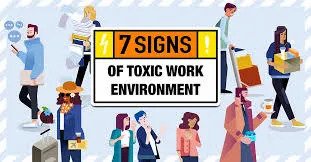
I’ve been researching, talking about and working with organizations, specifically on the issue of organizational culture, for several years now. One topic that continually arises is toxic organizational cultures – but interestingly, no one wants to admit that their organizations have them.
Or worse yet, that you’re actually working in one.
So – what are the hallmarks of toxic organizations and what do we do if we’re in one?
How Is It For You?
The first thing that most people notice unusually involves their own daily experience – typically regarding their manager. This makes sense because we’re all the center of our own universe. What does it look like if you’re working with a toxic manager or inside a team with toxic colleagues?
It can be super explicit. If your boss or coworkers belittle or bully you or others with their language‚ you are working in a toxic environment. You might be yelled at or addressed with derogatory comments or labels, your boss might use harsh or dismissive tones, or you may be the object of insults. Bullies, whether they’re conscious of their bullying or not – and whether they’re conscious of their impact or not – usually thrive on taking away the powers of others by inflicting emotional harm; this makes the victim feel incompetent or humiliated. This is how you’ll feel.

It can also be more covert, as seen in a boss who always demands agreement and rewards yes-men and women. Your manager might set impossibly high standards or may never be satisfied with the work you produce. They might give vague assignments and then complain when you weren’t able to read their mind. You might be excluded from activities or your manager may threaten to remove assignments from you. You might find your work – or even worse your worth – undermined, or find yourself excessively micromanaged. You’ll likely feel like you can never win. You may feel ineffective, inept and/or useless.

Within a team, toxicity may come from people who take credit for work they didn’t do, people who consistently fail to pull their own weight (leaving you or others to pick up the pieces or suffer the consequences), or people who play the “blame game.” You know – the super fun one where, when something goes wrong, someone else is always to blame. Someone else gets thrown under the bus, and it’s always someone else’s fault.
It may also be that you’re always working…always. On vacation. When you’re sick or caring for someone else in your family. Maybe even when you’ve taken off time for your own wedding. No matter the circumstances, your boss is compelling you to be “always on.” If you can’t take time away from work, your workplace may be toxic.
Within an organization as a whole, there are several other hallmarks of organizational toxicity.
Poor Communication
You work hard with no positive feedback and no recognition, and you might even be told to be glad you have a job at all.
Changes happen around the office that no one’s really talking about.
Employees are let go without notice being given to the rest of the team: they’re there one minute and gone the next.
You and others don’t get the necessary information to do your job. Assignments are vague and without clear standards.
People may receive bad performance reviews based on issues that could have been addressed months ago, had they been discussed.
There is a constant cycle of negativity. Conversations about work revolve around the employees’ unhappiness and frustration. There’s little to no enthusiasm, people aren’t happy to be there, and the dynamics are a lot like high school cliques.
 Gossip and Rumors: Everyone seems to be out for themselves, and there are very few genuine friendships among employees. There’s lots of infighting and paranoia as well as gossip and rumors. It may be rumors about the organization (Another reorg? Have you heard that the company is in financial trouble?). Or it may be gossip about people that’s usually very personal and never very nice. Regardless, significant levels of rumors and gossip are hallmarks of toxic cultures because they mean that internal information is being closely guarded rather than shared, and managers aren’t maintaining a hold on gossip as “not how we do things here.”
Gossip and Rumors: Everyone seems to be out for themselves, and there are very few genuine friendships among employees. There’s lots of infighting and paranoia as well as gossip and rumors. It may be rumors about the organization (Another reorg? Have you heard that the company is in financial trouble?). Or it may be gossip about people that’s usually very personal and never very nice. Regardless, significant levels of rumors and gossip are hallmarks of toxic cultures because they mean that internal information is being closely guarded rather than shared, and managers aren’t maintaining a hold on gossip as “not how we do things here.”
High turnover rates and people out sick a lot are also a measure of organizational toxicity. When the work environment has nothing good to offer except dysfunction, poor morale, and sickness, people will start heading for the door to find a better situation. If people aren’t staying around for more than a year or so, whether they’re getting fired or moving on to new positions, then you’re probably not working in a model office. Similarly, toxic workplaces lead to employee burnout, fatigue, and illness due to high levels of stress that wreak havoc on our bodies. If people are calling in sick or worse, are working sick, that’s a good sign of a toxic work environment.
There’s an exclusive club that runs the office and all the decisions, even if they’re not the ones at the top. Qualified people are passed over for promotions and raises in favor of underperforming employees. There’s nepotism. People who are contributing little to the organization are kept while great performers are let go.
There’s a culture of sexual harassment and/or discrimination. In the Me Too/Time’s Up age, it is now known that as many as eight in ten women will experience sexual harassment in the workplace at some point in their careers. Discrimination, whether on the basis of disability, gender, race, sexual orientation, age, or parental status is wrong, and it’s illegal.
In addition to the list above, trust your gut if it tells you something is wrong. Once you know what you’re dealing with, it’s time to develop strategies that can help you stay sane day-to-day.
Our next post will be about what to do if you now realize (or already knew) that you’re in a toxic work environment.
Our website www.JandJCG.com also has a cultural health assessment that you can take if you want more insights into how your organization stacks up. If you’re in an organization with a culture that’s toxic – or even just not great – you want to begin to think about how you can transform it. If it can’t be transformed, I encourage you to get serious about your exit strategy.
You DO deserve to be in an organization where people want to work, with employees who are engaged and people are loyal. We all do.






